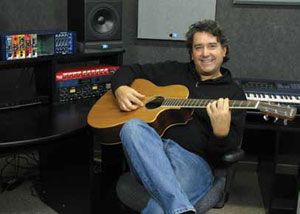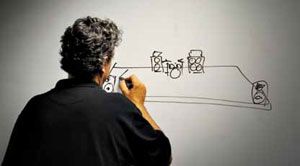Radial Engineering President Peter Janis Considers Every Angle in Product Development
Quick Bio
NAME: Peter Janis
TITLE: President
COMPANY: Radial Engineering
OVERTIME: Janis’ ability to see the “potholes” ahead has enabled Radial to put out many products that have never had a revision, some of which have been on the market for well over 10 years.
SCN: When you began your career circa 1976 as a guitarist working at a music store to pay the bills, what were you looking for—and not finding— in terms of technology available to musicians like you?

Radial Engineering president Peter Janis has built a career around musicianship, both on stage and in product development.
Peter Janis: I was playing several instruments on stage—keys and guitars for the most part. Switching between three amps on stage was a goal. So back then, we started to build our first switchers. We actually built loudspeakers and a lighting desk too!
SCN: After you met Denis Rozon and began collaborating on distortion pedals and three-channel guitar amplifiers under the Forest Electronics brand, what did you find most challenging about funneling your creative ideas into product development?
PJ: Actually, I came about the product development side naturally. I have always been able to see the potholes ahead, so I can predict many of the problems that users will encounter. This ‘knack’ has enabled Radial to put out many products that have never had a revision, some of which have been on the market for well over 10 years.
SCN: In the 1980s, you left Forest Electronics in Rozon’s hands and began working for Fender as product director for the Canadian market. How did working for that organization compare to your grassroots origins?
PJ: Fender was a tremendous learning experience. At the ripe old age of 24 I had the power to give or take away Fender from a dealer. This was very heady stuff. I learned how to negotiate with dealers with the goal of having them represent the line just as one would represent Ford or Toyota. Rarely did we pull the line from anyone unless they simply did not want to support the brand. After I left Fender, I continued to be well received by the dealer base because we always treated everyone with respect. I think this has played a tremendous part in how we run Radial as a company.
SCN: Asked to relocate to Fender’s LA office in 1991, you made the choice to stay put and launch a new distribution enterprise in Vancouver. What was it that drove your decision to then make the leap back into product development when you established Radial Engineering?

Janis said Radial has expanded its R&D department to bring much more control in house.
PJ: I live 22 minutes away from the U.S. border. With the advent of internet pricing, the old distribution model in Canada was under tremendous pressure due to the competitive nature of the U.S. market. Unless you had top U.S. brands such as Shure or a strong offshore brand like Ibanez, it was becoming more and more difficult to make any headway in the Canadian market. We had started to manufacture custom snake systems and studio patchbays early on as a means to sell Mogami cable, Jensen transformers, and so on, so the move to the direct box was really not that far of a leap. Once the first product got going in the market, the next one got easier!
SCN: Ten years ago, you and Rozon began working together again with the Tonebone brand. As your career has come full circle and you look forward to continued product innovation, what do you see as the most valuable knowledge you have gained?
PJ: Boy, that’s a tough one. Patience with people is probably at the top of the list. I want everything done now, and properly. This is very tough to achieve when you have over 50 personalities under one roof! Rozon played a critical role early on and we have since expanded our R&D department to bring much more control in house. To produce a quality product you really have to be on top of every little detail. This includes documentation, revisions, part selection, multiple sourcing, and so on. I am a huge believer in people and that we can do anything we want if we put our minds to it. But to get it done, it comes down to putting together a top-notch team. I think we have come a huge way in achieving this goal.
Kirsten Nelson is the editor of SCN.










